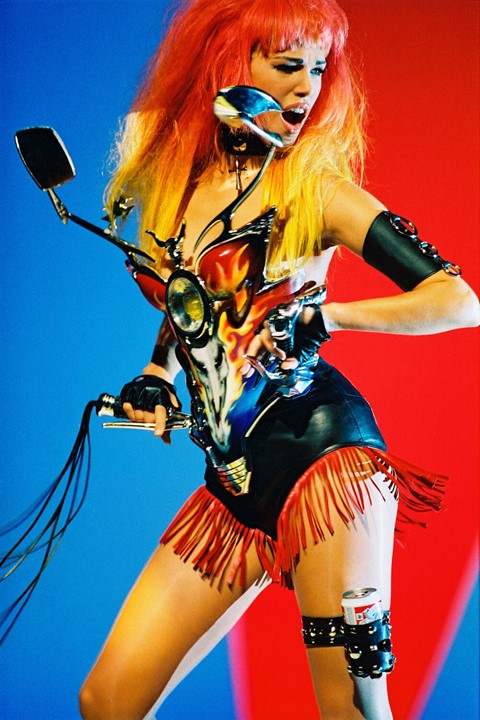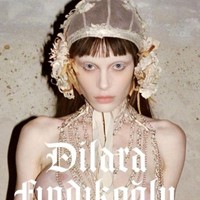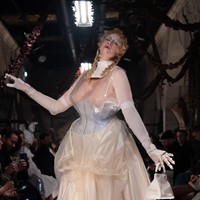His futuristic creations transformed women into supervixens and otherworldly creatures – but not without controversy
The legendary house of Thierry Mugler occupies the space between fashion and myth, manned by a designer so visionary that no less than Beyoncé, David Bowie and Lady Gaga have called upon him to create couture so haute your body temperature rises just looking at pictures of it. In celebration of his iconoclastic career, the Montreal Museum of Fine Arts has announced plans for Thierry Mugler: Creatures of Haute Couture, slated to open in February 2019. It will be the first solo exhibition of the designer’s work.
For over two decades, Mugler was a reigning force in fashion, an enfant terrible who defied bourgeois sensibilities with his spectacular looks and magnificent, sometimes almost hour-long runway shows. “I have always been fascinated by the most beautiful animal on the Earth: the human being,” Mugler revealed on the occasion of the exhibition’s announcement. That fascination led him to create clothes which transformed the wearers into futuristic femme fatales, whose superpowers were seduction and self-assurance.
Still, chances are you haven’t heard a whole lot from the designer lately. In 2003, Clarins, the parent company that purchased the brand in 1997, shuttered the house after huge losses (it would later reopen under Nicola Formichetti, followed by David Koma, who currently creates its collections). Mugler himself completely disappeared from public view, reemerging four years later as Manfred – virtually unrecognisable having embraced bodybuilding and transformed himself into a 240-pound figure rivalling a Tom of Finland sketch. He told the New York Times in 2010 that he did not want to be recognised, explaining, “You don’t want to be reminded that you did this or you did that. It is disturbing.”
But even if we might not recognise Manfred, we cannot forget Mugler, “the prophet of Futurism”, whose garments are, quite simply, a pleasure to behold. “Thierry Mugler is about the power of glamour and walking straight into the future,” Formichetti told Vogue in 2010. “He’s been a god for successive generations in the fashion industry. He fused pop and high fashion, told a story in style and combined fantasy with reality.” With an incredibly influential legacy, Mugler was finely attuned to the future, using his designs pushed the very boundaries of what fashion is – and does.
Born in 1948 in Strasbourg, France, Mugler “had a very hard time living in the world that is imposed upon us,” as he reveals on his website. “I dreamed of creating another world, to my scale,” he says. “One that was my own.” He took up ballet at a young age and began his professional training at 14 with the National Rhine Opera. For the next six years, Mugler lived on the stage, developing the perspective of a performer who must keep the attention of his audience. This experience informed his sensibilities, laying down a foundation that served him well throughout the years when it came to his spectacular runways. As he recently told ELLE, "When you’re onstage, you are someone else.”
After leaving the ballet, Mugler moved to Paris in 1968 to work as a window dresser for the boutique Gudule, and began designing on the side. After a few years of freelance work, Mugler launched “Café de Paris”, the first collection he designed under his own label, created in partnership with businessman Alain Caradeuc in 1973. Azzedine Alaïa soon joined Mugler, creating a look that combined the urban with the urbane, mixing punk aesthetics with the classic broad-shouldered suits inspired by the French military. In 1978, Mugler opened his first boutique at the Places des Victories and simultaneously launched his men’s line – he had arrived.
“Mugler’s designs became works of art, sculptures to be donned by divas, goddesses, and primadonnas who could transform into exotic creatures, erotic enigmas, and fantastical archetypes”
Equal parts innovator and iconoclast, Mugler’s designs became works of art, sculptures to be donned by divas, goddesses, and primadonnas who could transform into exotic creatures, erotic enigmas, and fantastical archetypes – perfectly timed with the rise of supermodel in the late 80s and early 90s. In shows that were more like dramatically orchestrated performances than what we see on the catwalk today, all the legends walked in Mugler’s famous creations – Naomi Campbell in one of those chrome and fibreglass car bodies, Cindy Crawford in a bondage bodysuit with nipple tassels, Linda Evangelista in a sequinned wig and gown, Eva Herzigova surrounded by red feathers... the list goes on.
Off the runway, Mugler worked as both director and costume designer for the 1992 video of George Michael’s “Too Funky.” In the video, Michael appears as a director filming a fictional fashion show that evokes the spirit of a Mugler production thanks to its compelling mix of top models, actresses, and cult icons including Herzigova, Evangelista, Tyra Banks, Nadja Auermann and Beverly Peele, along with drag legends Joey Arias and Lypsinka. In the director’s cut, Mugler added models-turned-actors Justin Chambers and Djimon Hounsou, and transformed the storyline from a cookie-cutter version of the fashion show to something far more wild and decadent.
At the time, the black gown Demi Moore wore in the 1993 film Indecent Proposal caused quite a stir, but in contrast to what Mugler was sending down the runways, the outfit was the height of demure. However, the designer’s love of vampy film noir silhouettes, with wide padded shoulders, tiny waists and flaring hips were not to everyone’s taste, and were deemed by some critics to be sexist. In 1982, one writer opined, “The liberation of women from being sex objects went out the window in the 10 days of the 1983 Paris spring/summer and ready-to-wear shows...” She found the work of Mugler and his contemporaries to be problematic, observing, “It could be fun fashion for some women, a put-down for other anti-sexist women.”
At the heart of it all was Mugler’s love of the corset, the long vilified garment that signified repression and the painful cost of female beauty standards. Modern fashion began when Paul Poiret and Coco Chanel designed garments without a waistline, and bras liberated women from garments so constricting they could cause health issues. But unlike the corsets of yore, Mugler’s designs did not oppress; perhaps paradoxically, they were symbols of power, control, and strength. In 1989, he met corset maker Mr Pearl at Susanne Bartsch’s Love Ball in New York City – and history was made as the two decided to collaborate on his upcoming runway show. As Mr Pearl remembered, “It had to be done in two weeks, and it was fully beaded – it was a hat, a corset, chaps, gauntlets, and shoes… It was quite daunting, I must say. He was very pleased with what we managed to do... Then he asked me to do more, until his house closed.”
With a mastermind like Mr Pearl on his team, Mugler incorporated metal, vinyl, latex, fake fur and diamante to divine his designs with otherworldly energies, restoring the corset to its rightful place: at the centre of the universe. By amplifying the bosom, nipping the waist, and flaring the hips, Mugler embraced the drama of hourglass figure that had long since been abandoned by a market that catered to the comforts of casual chic – the 90s was, after all, an era dominated by Calvin Klein slip dresses and Helmut Lang’s androgynous minimalism.
“All of his theatrical pieces can actually be ordered if you’re willing to pay the price,” Vogue once acknowledged of Mugler. Unfortunately, not enough people were willing or able to purchase Mugler’s ready-to-wear line, although perfumes, like 1992’s Angel, were wildly popular. By 1997, cosmetics firm Clarins became the majority shareholder of the house. Unfortunately, the merger was only able to keep the house afloat another few years. By 2003, Clarins announced the end of an era – sending Mugler underground.
But never count Mugler down and out. He took the world by storm once more when Beyoncé tapped him to be the creative advisor for her 2009 “I Am…” tour after seeing a corset in the Superheroes exhibition at the Metropolitan Museum Costume Institute. Mugler designed the costumes, including 58 for Beyoncé alone, directed three segments including the finale, and provided input on everything from lighting to choreography.
The designer told WWD that he wanted to create a look the captured “The duality between being a woman and a warrior,” and in doing so helped Beyoncé become a style icon and superhero in her own right. The elaborate costumes were rooted in the songs themselves, evoking what Mugler perceived as singer’s essence: “Feminine. Free. Warrior. Fierce.”
Those words could be used to describe the very ethos of Mugler’s work. His taste for grandeur and glamour created breathtaking silhouettes that fused the mystique of Old Hollywood with the infinite possibilities of science fiction. “The work of Thierry Mugler is as distinctive as it is avant-garde,” curator Thierry-Maxime Loriot observed when the new exhibition was announced. “This creator knows how to distinguish himself through constant innovation and audacious silhouettes that have marked an era, and found a place in the history of fashion. His singular style (is) a kind of futurist version of ‘New Look’ with a touch of fantasy and fetishism.”
Creatures of Haute Couture is not a retrospective but rather a prediction of things to come. The last room of the exhibition is titled “Couture Future” featuring clothing made exclusively for the exhibition, portending the direction we are heading in the new millennium. For Mugler fans, the show feels like it’s been a long time coming, but hopefully it will be a more than fitting tribute to the designer’s incredible archive and fashion legacy.




